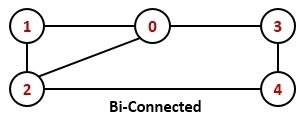
 Data Structure
Data Structure Networking
Networking RDBMS
RDBMS Operating System
Operating System Java
Java MS Excel
MS Excel iOS
iOS HTML
HTML CSS
CSS Android
Android Python
Python C Programming
C Programming C++
C++ C#
C# MongoDB
MongoDB MySQL
MySQL Javascript
Javascript PHP
PHP
- Selected Reading
- UPSC IAS Exams Notes
- Developer's Best Practices
- Questions and Answers
- Effective Resume Writing
- HR Interview Questions
- Computer Glossary
- Who is Who
Biconnected Graph
An undirected graph is said to be a biconnected graph, if there are two vertex-disjoint paths between any two vertices are present. In other words, we can say that there is a cycle between any two vertices.

We can say that a graph G is a bi-connected graph if it is connected, and there are no articulation points or cut vertex are present in the graph.
To solve this problem, we will use the DFS traversal. Using DFS, we will try to find if there is any articulation point is present or not. We also check whether all vertices are visited by the DFS or not, if not we can say that the graph is not connected.
Input and Output
Input: The adjacency matrix of the graph. 0 1 1 1 0 1 0 1 0 0 1 1 0 0 1 1 0 0 0 1 0 0 1 1 0 Output: The Graph is a biconnected graph.
Algorithm
isArticulation(start, visited, disc, low, parent)
Input: The start vertex, the visited array to mark when a node is visited, the disc will hold the discovery time of the vertex, and low will hold information about subtrees. The parent will hold the parent of the current vertex.
Output − True if any articulation point is found.
Begin time := 0 //the value of time will not be initialized for next function calls dfsChild := 0 mark start as visited set disc[start] := time+1 and low[start] := time + 1 time := time + 1 for all vertex v in the graph G, do if there is an edge between (start, v), then if v is visited, then increase dfsChild parent[v] := start if isArticulation(v, visited, disc, low, parent) is true, then return ture low[start] := minimum of low[start] and low[v] if parent[start] is φ AND dfsChild > 1, then return true if parent[start] is φ AND low[v] >= disc[start], then return true else if v is not the parent of start, then low[start] := minimum of low[start] and disc[v] done return false End
isBiconnected(graph)
Input: The given graph.
Output − True if the graph is bi-connected.
Begin initially set all vertices are unvisited and parent of each vertices are φ if isArticulation(0, visited, disc, low, parent) = true, then return false for each node i of the graph, do if i is not visited, then return false done return true End
Example
#include<iostream>
#define NODE 5
using namespace std;
int graph[NODE][NODE] = {
{0, 1, 1, 1, 0},
{1, 0, 1, 0, 0},
{1, 1, 0, 0, 0},
{1, 0, 0, 0, 1},
{0, 0, 0, 1, 0}
};
int min(int a, int b) {
return (a<b)?a:b;
}
bool isArticulation(int start, bool visited[], int disc[], int low[], int parent[]) {
static int time = 0;
int dfsChild = 0;
visited[start] = true; //make the first vertex is visited
disc[start] = low[start] = ++time; //initialize discovery time and the low time
for(int v = 0; v<NODE; v++) {
if(graph[start][v]) { //for all vertex v, which is connected with start
if(!visited[v]) {
dfsChild++;
parent[v] = start; //make start node as parent
if(isArticulation(v, visited, disc, low, parent))
return true;
low[start] = min(low[start], low[v]); //when subtree from v is connected to one of parent of start node
if(parent[start] == -1 && dfsChild > 1) { //when u have 2 or more children
return true;
}
if(parent[start] != -1 && low[v]>= disc[start])
return true;
} else if(v != parent[start]) //update low of start for previous call
low[start] = min(low[start], disc[v]);
}
}
return false;
}
bool isBiConnected() {
bool *vis = new bool[NODE];
int *disc = new int[NODE];
int *low = new int[NODE];
int *parent = new int[NODE];
for(int i = 0; i<NODE; i++) {
vis[i] = false; //no node is visited
parent[i] = -1; //initially there is no parent for any node
}
if(isArticulation(0, vis, disc, low, parent)) //when no articulation point is found
return false;
for(int i = 0; i<NODE; i++)
if(!vis[i]) //if any node is unvisited, the graph is not connected
return false;
return true;
}
int main() {
if(isBiConnected())
cout << "The Graph is a biconnected graph.";
else
cout << "The Graph is not a biconnected graph.";
}
Output
The Graph is a biconnected graph.

